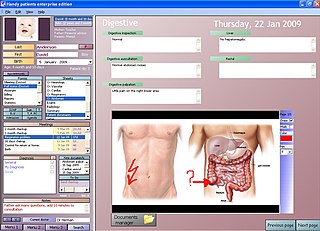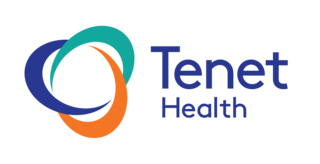History
Cerner was founded in 1979 by Neal Patterson, Paul Gorup, and Cliff Illig, who were colleagues at Arthur Andersen. Its original name was PGI & Associates but was renamed Cerner in 1984 when it rolled out its first system, PathNet. [9] It went public in 1986. [10] Cerner's client base grew steadily in the late 1980s, reaching 70 sites in 1987, 120 sites in 1988, 170 sites in 1989, and reaching 250 sites in 1990. Installations were primarily of PathNet systems. [11]
During this time, Cerner was developing components of a Health Network Architecture (HNA), an integrated IT system designed to automate health care processes. Clients could purchase individual components or the whole system at one time. By 1994, more than 30 clients had purchased the full HNA system, while 100 clients had purchased multiple components of the system. [11]
In 1997, the company introduced Cerner Millennium, an upgrade to its HNA system which incorporated all of the company's software offerings into one unified architecture. The introduction of Millennium contributed to significant growth for the company, with revenue increasing to $1.1 billion in 2005 [12] from $245.1 million in 1997. [13]
Cerner acquired IMC Health Care, Inc. in early 2010 to continue expanding its wellness services to outside commercial employers, pharmacies, and wellness programs. [14]
In July 2010, president Trace Devanny left the company [15] and Patterson became the company's president, in addition to his roles as chairman and chief executive officer. [16] In September 2013, Zane Burke was named president, assuming the title from Patterson. [17]
On August 5, 2014, Cerner announced its intent to purchase Siemens Health Services, the health information technology business of Germany's Siemens AG, for $1.3 billion. [18] The acquisition was completed on February 2, 2015. [19]
On July 29, 2015, Leidos Partnership for Defense Health, which includes Cerner, Accenture, and Leidos, was awarded a 10-year, $4.3 billion contract to overhaul and manage the electronic health records for the Department of Defense. [20]
CEO and co-founder Neal Patterson died July 9, 2017. [21] On January 10, 2018, Brent Shafer was named Chairman and CEO and took over leadership responsibilities in February 2018. [22]
On September 4, 2019, Cerner laid off 255 employees as part of an ongoing cost-cutting effort and reorganization. [23] This continued in February 2020 with Cerner selling parts of its healthcare IT business in Germany and Spain to German company CompuGroup Medical SE for €255 million. [24] [25]
In 2020, Cerner announced the hire of three new C-suite executives including Jerome Labat as chief technology officer (CTO), Darrell Johnson as chief marketing officer (CMO) and William Mintz as chief strategy officer (CSO). [26]
On August 19, 2021, Cerner announced that Dr. David Feinberg, vice-president and head of Google Health, will become President and CEO of Cerner, effective October 1, 2021. [27] [28]
On December 20, 2021, Oracle Corporation announced an agreement to buy Cerner for approximately $28.3 billion. [29] The deal closed in June 2022. [8]
Controversy
In 2001, a memo authored by CEO Patterson and sent to about 400 managers was leaked online. The memo, written in harsh language, was meant to motivate the managers to get more productivity out of employees and promised layoffs, a hiring freeze, closing of an "Associate Center," and the implementation of a punch-card system if Patterson did not see evidence of changes. Patterson's metric was the fullness of the company's Kansas City office lot at the hours of 8 a.m. and 5 p.m. The memo was widely seen as inflammatory and reflective of poor management, and Cerner's stock price fell 22% over three days. [32]
In 2005, Cerner and other companies paid for a report by the RAND Corporation which predicted great efficiencies from electronic health records, including savings of $81 billion a year or more, which RAND now says is overstated. This report helped drive growth in the electronic health record and billions of dollars in federal incentives to hospitals and doctors. Cerner's revenue tripled from $1 billion in 2005 to a projected $3 billion in 2013. The study was criticized by the Congressional Budget Office for overstating potential savings. A 2013 reassessment of the 2005 report by the RAND Corporation said that the conversion had failed to produce savings and had mixed results in efficiency and patient care. [33]
Australia
The Cerner Millennium product, including the FirstNet, SurgiNet/SurgiNet Anaesthesia and RadNet platforms, form the Integrated Electronic Medical Record (ieMR) system in the state of Queensland, Australia. ieMR is used throughout the state's public health and hospital system, Queensland Health. Delivered in tranches across the 16 regional Hospital and Health Services, the complete roll-out of Cerner Millennium has drawn criticism at a cost of over A$1.45 billion and taking more than 10 years to roll-out across the state. [34] As of 2023, works continues to roll-out ieMR across the across remaining non-digital and partially digital facilities. [35]
In 2018, Queensland Health through its digital health solutions agency, eHealth Queensland, began a restricted tender process to purchase a Patient Administration System (PAS) solution, to replace the aging iSoft PAS first introduced in the early 1990s. [36] The procurement process was successful with the Cerner PAS solution being chosen. In early 2019, allegations arose surrounding an undeclared relationship and conflict of interest between Richard Ashby, chief information officer of eHealth Queensland, and a Cerner employee. The allegations resulted in the resignation of Ashby, the matter being referred to the Queensland Crime and Corruption Commission for investigation, and the collapse of the PAS replacement project. [37] The commission subsequently found insufficient evidence to prosecute Ashby for corrupt conduct. [38]
Canada
In 2016, the emergency department of Nanaimo Regional General Hospital in Nanaimo, British Columbia began using the system. The implementation, which cost $230 million, [39] was met with widespread criticism, with staff calling it a "huge failure" due to an increase in software errors resulting in reduced efficiency of the department. [40] An investigation by British Columbia's Health Ministry indicated that the project was not correctly planned or implemented and that organizational dysfunction at the facility contributed to the failure. [41]
United Kingdom
In 2014, a coroner ruled that a three-year-old heart patient died as a result of a delay to his treatment at Bristol Royal Hospital for Children. The coroner ruled that the hospital's outpatient booking system was responsible for the child not being seen or receiving treatment. [42] The Royal United Hospital had recently installed the Cerner Millennium system. However appointments for the hospital's legacy booking system were not migrated to the new system. [43]
United States
In 2002, the installation of a computerized health system by Cerner in the UPMC Children's Hospital of Pittsburgh made it harder for the doctors and nurses to do their jobs in emergency situations and resulted in a "disaster," according to Phillip Longman, a senior fellow at the New America Foundation. Longman wrote, "According to a study conducted by the hospital and published in the journal Pediatrics , mortality rates for one vulnerable patient population—those brought by emergency transport from other facilities—more than doubled, from 2.8 percent before the installation to almost 6.6 percent afterward." [44] Defenders of Cerner in the study charged that the Pittsburgh hospital did not adequately prepare for the transition to the Computerized Provider Order Entry (CPOE) system because it had simultaneously modified its pharmacy process, did not provide adequate wireless bandwidth, and did not have order sets pre-programmed on day one. They stated that other hospitals that more carefully planned the implementation did not experience the same problems. [45]
In 2010, Girard Medical Center, Crawford County, Kansas, hired Cerner to install an electronic records system. But after receiving $1.3 million, Cerner employees failed to get the system running in time to qualify for federal incentive payments, and in September 2011, notified the hospital that it was abandoning the project, according to a lawsuit Girard filed against Cerner. Cerner and executives at Girard agreed that Girard did not have adequate staff to manage the acquisition and implementation of the system. [46] As of June 2014, the case remained in arbitration. [33] [47] The outcome of the Girard case will likely be kept confidential due to contract provisions. [48]
In 2012, Trinity Health, a large hospital in North Dakota, sued Cerner, claiming that Cerner's patient accounting software didn't work correctly; the parties settled for $106M in 2014. [49]
In 2014, a grand jury in California found that Cerner knew that the Ventura County healthcare agency was unprepared to complete a $32 million installation. Also in 2014, a $31 million Cerner implementation at the Athens Regional Health System in Georgia had many problems, leading to forced resignations by the CEO and the CIO of ARHS. [47]
Sweden
Concern has been expressed that the US CLOUD Act could enable US authorities to request data managed by US companies. It has been reported in Sweden that patient data managed by Cerner might be disclosed based on this requirement. Based on this concern, the Vastra Gotland and Scania regional health care systems have decided to store any patient data managed by Cerner in Swedish data centers. [50]
In 2022, the regional director of the Vastra Gotaland health care system in Sweden sent a letter to Cerner claiming a breach of contract for deployment of the Millenium system. The letter stated that there were numerous issues with the system that Cerner had declined to address. At the same time, a deployment of Millenium in region Skane has been delayed but is moving forward. [51] [52]













